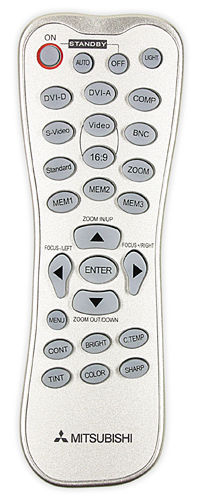Mitsubishi HC2000 front DLP projector Page 2
To exercise the HC2000, I cycled through several HDTV programs. Because my local Fox affiliate (WTXF-DT) has begun broadcasting in high-definition, I recorded a New York Giants–Philadelphia Eagles football game in 720p to D-VHS for critical viewing. I also used clips from CBS football (1080i), NBC's Olympics coverage (1080i), and ABC's NBA Finals (720p).
To check out the HC2000's 480i inputs, I put my timeworn copy of the Video Essentials test DVD to work, along with a new Benchmark DVD from Silicon Optix that has some particularly tough tests for deinterlacing and motion interpolation. Men In Black provided the images with which I tested for shadow detail, noise, and false contouring.
 Earlier, I mentioned problems with the HC2000 locking on to different signal formats. There were times when the projector wouldn't recognize 1080i and 720p DVI-HDCP signals from three different set-top boxes (LG LST3100A terrestrial DTV, Samsung SIR-T165 terrestrial DTV, and Motorola DCT6200 digital cable). The images would appear either all red, as a split screen with two versions of the same image, or not at all. The problem was finally solved when I set the output resolution of each set-top box to 480p and allowed the HC2000 to sync to that signal, then reset the three receivers to 1080i or 720p output.
Earlier, I mentioned problems with the HC2000 locking on to different signal formats. There were times when the projector wouldn't recognize 1080i and 720p DVI-HDCP signals from three different set-top boxes (LG LST3100A terrestrial DTV, Samsung SIR-T165 terrestrial DTV, and Motorola DCT6200 digital cable). The images would appear either all red, as a split screen with two versions of the same image, or not at all. The problem was finally solved when I set the output resolution of each set-top box to 480p and allowed the HC2000 to sync to that signal, then reset the three receivers to 1080i or 720p output.
Content at 720p and 1080i delivered in the RGBHV format was also a hit-or-miss proposition with the HC2000. (This is the format I use at home, and one the Optoma H77 had lots of trouble with during the Super Bowl.) Sometimes the projector would endlessly cycle through onscreen displays reading "searching," "detected," "auto setup," and "setup complete" without accomplishing anything. Other times, it would acquire the signal after I'd cycled through several different inputs. Switching back to the DVI or component input after this happened often resulted in that weird split-screen effect again. There's obviously a ghost in this machine that Mitsubishi needs to exorcise.
The HC2000 did a mediocre job of color-decoding composite-video signals. Using the Snell & Wilcox Zone Plate on VE, I saw beaucoup color moiré and dot crawl, and not much picture detail at 300 and 400 lines. Use this input only if you have to! (To paraphrase that old Chicago song, "Does anybody really use composite-video anymore? Does anybody really care?")
The picture quality improved tremendously using the S-video and component inputs, but there was a catch. I swept the HC2000's component inputs for frequency response and found them good only to 12.5MHz—enough for a 480p standard-definition source. Multiburst patterns at 18.5MHz in both 720p and 1080i mode banded noticeably, and 37.5MHz patterns were grayed out. If you watch a lot of HDTV, use your set-top box's RGBHV or DVI outputs to get the most picture detail. Both of these inputs had significantly better frequency response out to 18.5MHz.
It won't come as a surprise that 720p clips looked best on the HC2000. Fox's hi-def telecast of the Giants-Eagles game had excellent detail and crisp pictures, although there appeared to be some MPEG encoding artifacts in WTXF's digital signal that, on close inspection, appeared as faint mosquito noise. The 720p NBA Finals clips played exceptionally well, with smooth action, great color, and good (not great) shadow detail.
Men In Black revealed that, like all DLP projectors, the HC2000 had its limits. I put my Panasonic RP56 DVD player in 480p output mode to get the best picture quality. With the Black Stretch control set to –2, the White Enhance to 0, and Gamma to Theater 2, pictures from the HC2000 set were as sharp as I could expect from the Faroudja FLI2100 DCDi chipset in the RP56, and were relatively free of noise except in deep shadows. The HC2000's black-level perfor-mance was about the same as that of other DLP projectors I've tested—blacks looked good at first, but when I compared them to my reference Princeton AF3.0HD CRT monitor, I could see how much detail was still missing.
The HC2000's deinterlacing performance was average. It had trouble picking up the change from 30fps video to 3:2 material on the Silicon Optix Benchmark DVD, and the waving-flag sequence from VE revealed some scan-line artifacts. A good external video scaler or 480p DVD source with superior deinterlacing fixed this problem nicely.
Conclusions
Mitsubishi's HC2000 is an interesting beast. It does have a few flaws. Somehow, I expected more light output from it, given the relatively large projector housing and powerful lamp. Its signal-detection circuit needs work, and the input bandwidth for component signals must be wider to accommodate those folks with digital TV receivers that have only Y-Pb-Pr outputs. From my tests, it was evident that this projector craves HD signals; an outboard scaler for standard-definition material is highly recommended.
Where the HC2000 excels is in its gray-scale reproduction (see "calibration" sidebar). You can get some really nice pictures out of it with the correct settings of brightness and contrast and careful adjustment of the white balance. Couple the HC2000's outstanding gray-scale performance with a steady diet of HDTV programs or DVDs (converted to 720p) through the DVI input, and the HC2000 will really shine.




























































